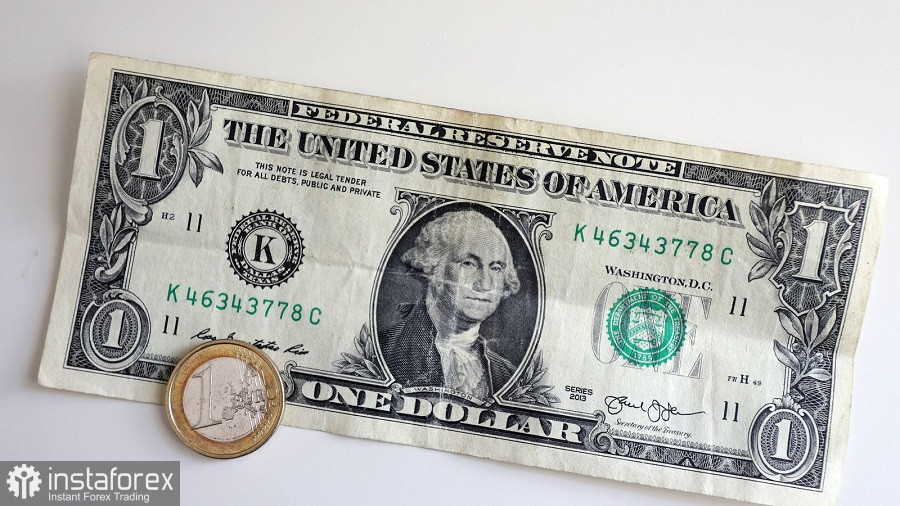Buyers of the EUR/USD pair demonstrated an impressive rally: within two trading days, the price rose by almost 300 points after a prolonged downward decline into the 97th figure area. Such a serious upward breakthrough was due to several reasons, which, so to speak, resonated.
The starting point was nonfarm data: unemployment unexpectedly rose to 3.7%, and the growth rate of average wages slowed to 4.7%. However, the report on the labor market in the United States was only the first link in the chain of events. Traders extrapolated this release to the words of Jerome Powell, who, following the results of the Fed's November meeting, warned of a possible slowdown in the pace of interest rate hikes in the coming months. Contradictory nonfarm payrolls suggested that this would happen at the next meeting, that is, in December.
According to the CME FedWatch Tool, the probability of implementing a 50-point scenario at the December meeting increased to 52%. Accordingly, the probability of an increase in the rate by 75 points is estimated at 48%.

This is the main reason for the weakening of the US currency. But not the only one. The fact is that, at the start of a new trading week, the market has increased interest in risk. Traders reacted positively to the geopolitical news, which is of a de-escalation nature. In particular, a representative of the Russian Foreign Ministry said today that the governments of Russia and the United States continue to maintain point-to-point contacts "in the areas necessary for each other." A similar statement was made by the US President's national security adviser.
In addition, yesterday, it became known that Russia and the United States may soon hold a meeting of the bilateral advisory commission on the Strategic Arms Reduction Treaty (START III). Although this information is unofficial, it also had a certain impact on the mood of traders.
Interest in risk also increased against the backdrop of German macroeconomic reports. Germany has published data on industrial production for September. The release came out in the "green zone": on a monthly basis, the indicator rose by 0.6% (with a forecast of growth to 0.2% and a decline of 0.6% in the previous month), and in annual terms jumped immediately by 2.6% (with a growth forecast of only 0.5%).
The above fundamental factors allowed EUR/USD buyers to strengthen the upward momentum: the pair ended yesterday's trading day at 1.0020.
However, traders failed to stay above the parity level again. Today, the upward momentum has actually faded.
First, it must be emphasized that any upward spikes in the pair are in the nature of corrective pullbacks, which are a priori temporary. It will be possible to talk about the first signs of a trend reversal only when the price consolidates above the 1.0060 resistance level (the upper line of the Bollinger Bands indicator on the daily chart).
Secondly, many traders, in my opinion, exaggerate the significance of the fact that the Fed will soon weaken the pace of quantitative tightening. And in general, it does not matter when exactly this will happen—in December or February. After all, the main trump card of the US currency is that the regulator has expressed willingness to expand horizons by exceeding the 5 percent rate level.
By the way, Goldman Sachs experts this week updated their three-month forecast for the EUR/USD pair: in their opinion, the price will decline not to the area of the 97th figure but to the area of the 0.9400 mark. Justifying their opinion, currency strategists refer to the results of the Fed's November meeting. In their opinion, the Central Bank has actually recognized that measures to tighten monetary policy are a "moving target" that is moving higher and higher.
Thirdly, the issue of slowing down the pace of monetary policy tightening is debatable: Fed members at the December meeting will discuss the feasibility of this step. And here, a lot will depend on the dynamics of inflation growth in the United States. Note that the day after tomorrow, November 10, we will find out the value of the consumer price index (for October). If the data turns out to be in the "green zone," then the hawkish position of the Fed will manifest itself more clearly, while the speed of the rate increase will become a secondary factor.
That is why, in my opinion, it will be difficult for buyers of EUR/USD to gain a foothold above the parity level, not to mention overcoming the price barrier of 1.0060 (if the inflation report comes out at least at the level of forecasts).
At the same time, it is quite risky to open trading positions on the EUR/USD pair in the coming days, given the high degree of uncertainty. This uncertainty is due to the midterm elections to the US Congress. According to experts, the Democrats will lose control either of both chambers, or only of the House of Representatives (retaining control of the Senate). It is noteworthy that there is no consensus in the market on how the dollar will react to this fact. For the most part, analysts are talking about a negative reaction, although some experts admit the possibility that the greenback will be in high demand as a protective asset.
In any case, there is a high probability of increased turbulence, and in such conditions, it is best to take a wait-and-see attitude.
 English
English 
 Русский
Русский Bahasa Indonesia
Bahasa Indonesia Bahasa Malay
Bahasa Malay ไทย
ไทย Español
Español Deutsch
Deutsch Български
Български Français
Français Tiếng Việt
Tiếng Việt 中文
中文 বাংলা
বাংলা हिन्दी
हिन्दी Čeština
Čeština Українська
Українська Română
Română

